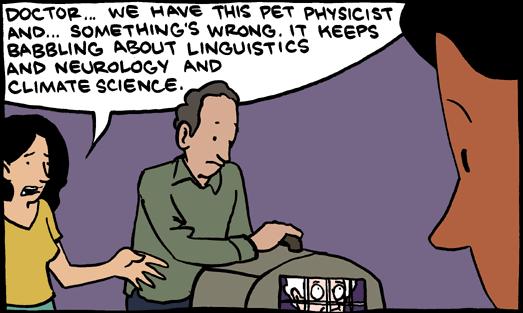Saturday morning breakfast cereal just ran an excellent commentary on interdisciplinary (ex-pat?) physicists.
This cartoon just kept popping into my mind as I read a recent paper on gradient sensing (i.e. the single cell version of "sniff sniff, the cake is that way"). The paper was studying amoebas (that's Dictyostelium discoideum to you) that normally spend their lives crawling around hunting bacteria. They move and hunt much like white blood cells do, but they're a lot easier to work with since, since they divide in half every few hours so you don't have to bleed a mouse every time you want more. For a cool movie showing how these cells should move, check out my previous post.
I was a bit concerned by the lack of cell movement in the paper's figures, so I went to their supplemental online info, downloaded their movies, clicked play, and waited for the cells to move. Then the movie ended. Not only did the cells not move anywhere, but over 15 minutes they barely even wiggled (movie not in real time).
So to me, this immediately raised the question: was this a peer-reviewed paper on dead cells? Now to be fair, the cells still responded biochemically to chemoattractant pulses (i.e. whiffs of chocolate cake), which was the topic of the study. But hey, if you zap a severed frog leg with electricity, it will respond. Doesn't mean you're studying a live frog. One possible problem: the methods mentions doing their experiments at 11 degrees C (52 F), a temperature we keep Dicty cells when we want them to NOT do much.
Pic 2
Apparently I am aging prematurely
So here we have a detailed quantitative analysis of half-dead cells in a refrigerator. Why? Sounds like a lack of respect for the system to me. It is tempting for scientists from one field (in this case physicists/engineers) to believe that since they are experts in their field, that means studying anything else is automatically easy. It's not. When I transitioned to biophysics* out of a physics undergrad degree, it took me a long time to figure out all the things that can go wrong in biology experiments.
This paper isn't the only case of physicist hubris I've come across. I believe a friend of mine spent several months studying cells he had killed first by focusing on them with intense UV light. There's another paper that fit a wonderful mathematical distribution to albatross flight dynamics, except it turned out the data they were using included the time spent by the experimentalists driving back and forth from their research station before they turned off their flight trackers.
* The term "biophysics" seems to mean anything the speaker/writer wants it to mean, so long as there is at least one differential equation involved.



